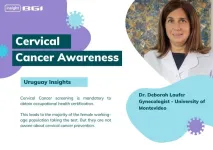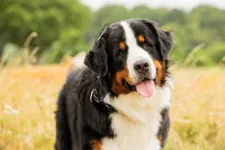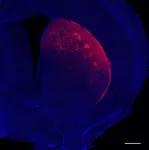(Press-News.org) ITHACA, N.Y. -- Cornell researchers used magnetic imaging to obtain the first direct visualization of how electrons flow in a special type of insulator, and by doing so they discovered that the transport current moves through the interior of the material, rather than at the edges, as scientists had long assumed.
The finding provides new insights into the electron behavior in so-called quantum anomalous Hall insulators and should help settle a decades-long debate about how current flows in more general quantum Hall insulators. These insights will inform the development of topological materials for next-generation quantum devices.
The team’s paper, “Direct Visualization of Electronic Transport in a Quantum Anomalous Hall Insulator,” published Aug. 3 in Nature Materials. The lead author is Matt Ferguson, Ph.D. ’22, currently a postdoctoral researcher at the Max Planck Institute for Chemical Physics of Solids in Germany.
The project, led by Katja Nowack, assistant professor of physics in the College of Arts and Sciences and the paper’s senior author, has its origins in what’s known as the quantum Hall effect. First discovered in 1980, this effect results when a magnetic field is applied to a specific material to trigger an unusual phenomena: The interior of the bulk sample becomes an insulator while an electrical current moves in a single direction along the outer edge. The resistances are quantized, or restricted, to a value defined by the fundamental universal constant and drop to zero.
A quantum anomalous Hall insulator, first discovered in 2013, achieves the same effect by using a material that is magnetized. Quantization still occurs and longitudinal resistance vanishes, and the electrons speed along the edge without dissipating energy, somewhat like a superconductor.
At least that is the popular conception.
“The picture where the current flows along the edges can really nicely explain how you get that quantization. But it turns out, it’s not the only picture that can explain quantization,” Nowack said. “This edge picture has really been the dominant one since the spectacular rise of topological insulators starting in the early 2000s. The intricacies of the local voltages and local currents have largely been forgotten. In reality, these can be much more complicated than the edge picture suggests.”
Only a handful of materials are known to be quantum anomalous Hall insulators. For their new work, Nowack’s group focused on chromium-doped bismuth antimony telluride – the same compound in which the quantum anomalous Hall effect was first observed a decade ago.
The sample was grown by collaborators led by physics professor Nitin Samarth at Pennsylvania State University. To scan the material, Nowack and Ferguson used their lab’s superconducting quantum interference device, or SQUID, an extremely sensitive magnetic field sensor that can operate at low temperatures to detect dauntingly tiny magnetic fields. The SQUID effectively images the current flows – which are what generate the magnetic field – and the images are combined to reconstruct the current density.
“The currents that we are studying are really, really small, so it’s a difficult measurement,” Nowack said. “And we needed to go below one Kelvin in temperature to get a good quantization in the sample. I’m proud that we pulled that off.”
When the researchers noticed the electrons flowing in the bulk of the material, not at the boundary edges, they began to dig through old studies. They found that in the years following the original discovery of the quantum Hall effect in 1980, there was much debate about where the flow occurred – a controversy unknown to most younger materials scientists, Nowack said.
“I hope the newer generation working on topological materials takes note of this work and reopens the debate. It’s clear that we don’t even understand some very fundamental aspects of what happens in topological materials,” she said. “If we don’t understand how the current flows, what do we actually understand about these materials?”
Answering those questions might also be relevant for building more complicated devices, such as hybrid technologies that couple a superconductor to a quantum anomalous Hall insulator to produce even more exotic states of matter.
“I’m curious to explore if what we observe holds true across different material systems. It might be possible that in some materials, the current flows, yet differently,” Nowack said. “For me this highlights the beauty of topological materials – their behavior in an electrical measurement are dictated by very general principles, independent of microscopic details. Nevertheless, it’s crucial to understand what happens at the microscopic scale, both for our fundamental understanding and applications. This interplay of general principles and the finer nuances makes studying topological materials so captivating and fascinating.”
Co-authors include doctoral student David Low; and Penn State researchers Nitin Samarth, Run Xiao and Anthony Richardella.
The research was primarily supported by the U.S. Department of Energy’s Office of Basic Energy Sciences, Division of Materials Sciences and Engineering.
Material growth and sample fabrication was supported by the 2D Crystal Consortium – Materials Innovation Platform (2DCC-MIP), which is funded by the National Science Foundation, at Penn State.
-30-
END
Current takes a surprising path in quantum material
2023-08-03
ELSE PRESS RELEASES FROM THIS DATE:
Professor Deborah Laufer discusses barriers to cervical cancer screening in Uruguay – BGI Insights
2023-08-03
The recently released BGI Genomics 2023 Global State of Cervical Cancer Awareness Report highlights the level of knowledge, attitudes, and practices related to cervical cancer screening and the human papillomavirus (HPV) on a global scale.
Dr. Deborah Laufer, a gynecologist and Associate Professor at the Faculty of Medicine in the University of Montevideo, offers her insights on this report's findings and the steps needed to improve cervical cancer awareness in Uruguay.
Q: 40% of respondents worldwide did not choose HPV as the key cause of cervical cancer. 37% in Uruguay did not mention it either. ...
Researchers strengthen defenses against common cyberattack
2023-08-03
RICHLAND, Wash.—Scientists have developed a better way to recognize a common internet attack, improving detection by 90 percent compared to current methods.
The new technique developed by computer scientists at the Department of Energy’s Pacific Northwest National Laboratory works by keeping a watchful eye over ever-changing traffic patterns on the internet. The findings were presented on August 2 by PNNL scientist Omer Subasi at the IEEE International Conference on Cyber Security and Resilience, where the manuscript was recognized as the best research paper presented at the meeting.
The ...
Mussel-inspired membrane can boost sustainability and add value to industrial wastewater treatment
2023-08-03
Engineers have developed a new kind of membrane that separates chemicals within wastewater so effectively that they can be reused, presenting a new opportunity for industries to improve sustainability, while extracting valuable by-products and chemicals from wastewater.
Created for use in wastewater treatment, the thin-film composite nanoporous membrane known as a TFC NPM, exhibits an ‘unprecedented’ capability to separate salts and other chemical components from water, and could lead to more sustainable treatment and management of water in a range of industries.
A research ...
CAR-T immune therapy attacks ovarian cancer in mice with a single dose
2023-08-03
CHAMPAIGN, Ill. — CAR-T immune therapies could be effective against solid tumors if the right targets are identified, a new study led by University of Illinois Urbana-Champaign researchers suggests. The researchers successfully deployed CAR-T in a mouse model of ovarian cancer, a type of aggressive, solid-tumor cancer that has eluded such therapies until now.
“Even with an advanced stage tumor model, even with a single dose, we saw strong anti-tumor effects,” said Diana Rose Ranoa, ...
GABA receptors in brain could be targets to treat depression and its cognitive symptoms
2023-08-03
CHAMPAIGN, Ill. — Depression is a complex condition correlated with multiple differences in brain function and mechanisms. A new paper spanning known data about the neurotransmitter GABA and its principal receptors showcases evidence of the receptors’ importance in depression and potential as therapeutic targets.
Based on evidence from research on the receptors’ function in the brain and the drugs that can activate or inhibit them, the authors propose possible mechanisms by which GABA-modulating treatments could ...
New clinical trial to assess canine cancer treatment
2023-08-03
DENVER/Aug. 3, 2023 – A newly funded study will evaluate the potential of a cancer drug to control tumor growth and improve outcomes for dogs with histiocytic sarcoma, an aggressive and typically fatal canine cancer.
The multi-center clinical trial is being conducted at Michigan State University, University of Florida, University of Wisconsin and Virginia Tech, and funded by the Bernese Mountain Dog Club of America through Morris Animal Foundation's Donor-Inspired Study program. Histiocytic sarcoma was ...
How sensory neurons impact the gut
2023-08-03
LA JOLLA, CA—Gastrointestinal and digestive issues impact roughly 3 million people across the United States alone, and that number is growing. A new study from Scripps Research scientists shows how sensory neurons control our gastrointestinal tracts—critical information that could shape our understanding of related diseases and disorders.
The study, published in the journal Cell on Aug. 3rd, 2023, used a combination of human clinical data and animal models to reveal that the receptor PIEZO2 controls gastrointestinal transit through the stomach, small intestine, and colon by sensing the presence of food and slowing the rate of gut motility accordingly. These ...
Study finds hallmarks of T cell exhaustion within hours of tumor exposure
2023-08-03
Immune system T cells that should be able to kill cancer cells become dysfunctional or “exhausted” within hours of encountering a tumor, according to a study reported Aug. 3 in Nature Immunology.
The surprising findings have implications for cancer immunotherapies that aim to harness the tumor-killing power of T cells, and they challenge existing ideas about how T cells become exhausted, said Mary Philip, MD, PhD, assistant professor of Medicine in the Division of Hematology and Oncology ...
New research casts doubt on role of fungus in driving pancreatic cancer
2023-08-03
DURHAM, N.C. – Four years ago, a report that a common species of fungus might fuel pancreatic cancer offered a promising new view of the deadly disease.
But in working to validate the finding, Duke Health researchers have found no such association. In a study appearing online Aug. 3 in the journal Nature, the Duke researchers conducted a multi-pronged analysis of data from the earlier study and found no link between the pancreatic microbiome and the development of pancreatic cancer.
“We were intrigued by the original finding, as were ...
Dopamine controls movement, not just rewards
2023-08-03
Dopamine: It’s not just for rewards anymore.
In a new Northwestern University-led study, researchers identified and recorded from three genetic subtypes of dopamine neurons in the midbrain region of a mouse model.
Although there is a long-standing, common assumption that most — if not all — dopamine neurons solely respond to rewards or reward-predicting cues, the researchers instead discovered that one genetic subtype fires when the body moves. And, even more surprisingly, these neurons curiously do not respond to rewards at all.
Not only ...





